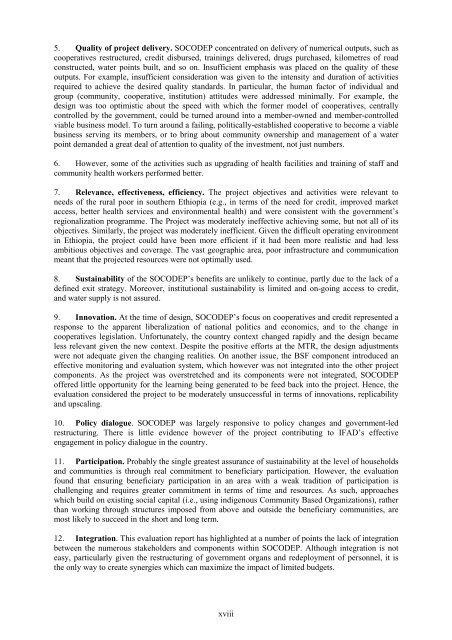Ethiopia SOCODEP CE - main report - IFAD
Ethiopia SOCODEP CE - main report - IFAD
Ethiopia SOCODEP CE - main report - IFAD
Create successful ePaper yourself
Turn your PDF publications into a flip-book with our unique Google optimized e-Paper software.
5. Quality of project delivery. <strong>SOCODEP</strong> concentrated on delivery of numerical outputs, such as<br />
cooperatives restructured, credit disbursed, trainings delivered, drugs purchased, kilometres of road<br />
constructed, water points built, and so on. Insufficient emphasis was placed on the quality of these<br />
outputs. For example, insufficient consideration was given to the intensity and duration of activities<br />
required to achieve the desired quality standards. In particular, the human factor of individual and<br />
group (community, cooperative, institution) attitudes were addressed minimally. For example, the<br />
design was too optimistic about the speed with which the former model of cooperatives, centrally<br />
controlled by the government, could be turned around into a member-owned and member-controlled<br />
viable business model. To turn around a failing, politically-established cooperative to become a viable<br />
business serving its members, or to bring about community ownership and management of a water<br />
point demanded a great deal of attention to quality of the investment, not just numbers.<br />
6. However, some of the activities such as upgrading of health facilities and training of staff and<br />
community health workers performed better.<br />
7. Relevance, effectiveness, efficiency. The project objectives and activities were relevant to<br />
needs of the rural poor in southern <strong>Ethiopia</strong> (e.g., in terms of the need for credit, improved market<br />
access, better health services and environmental health) and were consistent with the government’s<br />
regionalization programme. The Project was moderately ineffective achieving some, but not all of its<br />
objectives. Similarly, the project was moderately inefficient. Given the difficult operating environment<br />
in <strong>Ethiopia</strong>, the project could have been more efficient if it had been more realistic and had less<br />
ambitious objectives and coverage. The vast geographic area, poor infrastructure and communication<br />
meant that the projected resources were not optimally used.<br />
8. Sustainability of the <strong>SOCODEP</strong>’s benefits are unlikely to continue, partly due to the lack of a<br />
defined exit strategy. Moreover, institutional sustainability is limited and on-going access to credit,<br />
and water supply is not assured.<br />
9. Innovation. At the time of design, <strong>SOCODEP</strong>’s focus on cooperatives and credit represented a<br />
response to the apparent liberalization of national politics and economics, and to the change in<br />
cooperatives legislation. Unfortunately, the country context changed rapidly and the design became<br />
less relevant given the new context. Despite the positive efforts at the MTR, the design adjustments<br />
were not adequate given the changing realities. On another issue, the BSF component introduced an<br />
effective monitoring and evaluation system, which however was not integrated into the other project<br />
components. As the project was overstretched and its components were not integrated, <strong>SOCODEP</strong><br />
offered little opportunity for the learning being generated to be feed back into the project. Hence, the<br />
evaluation considered the project to be moderately unsuccessful in terms of innovations, replicability<br />
and upscaling.<br />
10. Policy dialogue. <strong>SOCODEP</strong> was largely responsive to policy changes and government-led<br />
restructuring. There is little evidence however of the project contributing to <strong>IFAD</strong>’s effective<br />
engagement in policy dialogue in the country.<br />
11. Participation. Probably the single greatest assurance of sustainability at the level of households<br />
and communities is through real commitment to beneficiary participation. However, the evaluation<br />
found that ensuring beneficiary participation in an area with a weak tradition of participation is<br />
challenging and requires greater commitment in terms of time and resources. As such, approaches<br />
which build on existing social capital (i.e., using indigenous Community Based Organizations), rather<br />
than working through structures imposed from above and outside the beneficiary communities, are<br />
most likely to succeed in the short and long term.<br />
12. Integration. This evaluation <strong>report</strong> has highlighted at a number of points the lack of integration<br />
between the numerous stakeholders and components within <strong>SOCODEP</strong>. Although integration is not<br />
easy, particularly given the restructuring of government organs and redeployment of personnel, it is<br />
the only way to create synergies which can maximize the impact of limited budgets.<br />
xviii

















